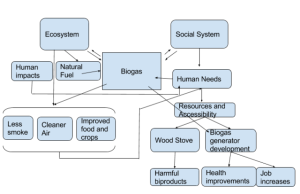The basis behind my diagram is the idea of “systems perspective” and “system diagrams,” because no matter what you are dealing with, everything in the human or social system affects everything in the ecosystem, and everything in the ecosystem affects everything in the social system. If you look at these systems as having both direct and trickle-down effects, you will find that small changes lead to big ripple effects. As I have found in the module, biogas is one factor that can have a positive effect on both the environmental or ecosystem spheres, as well as the social system. Using biogas led to cleaner air and byproducts, leading to healthier populations of humans, and an increase in the job opportunities for women especially.
Gerry Marten’s diagram differs because it displays much more broad concepts about the ecosystem and social system such as “knowledge,” “population,” and “animals.” While this is somewhat similar to my diagram in that there are core facets that may be affected no matter what, it is different because it does not identify specific relationships that were presented in the biogas case. One thing that Marten’s diagram does do, however, is represent the two systems as a cyclical process. In retrospect I should have done this as well.


Hey Hannah,
Your diagram has a different perspective of the Biogas System than I expected. Also, you captured more components than I did. The little details make a difference. Good job!
Check out my post: https://sites.psu.edu/geog30/wp-admin/post.php?post=43037&action=edit
Hello Hannah! You did a great job emphasizing the chain of positive effects from using the sustainable biogas tank. Your diagram is very easy to follow. I noticed you did not label your arrows and it wasn’t necessary because you displayed everything so clearly. We both focused on the benefits from using the biogas technology and its sustainability. Similarly to your system diagram, my diagram also mentioned the wood fired stove. You did a great job and if you get a chance, take a look at my post! http://geog030.dutton.psu.edu/2016/01/27/module-ii-biogas-in-india/
Thank you.
Sincerely,
Tawnya
Hey Hannah, I like how you did your diagram. Comparing it to mine, our designs look very different. You also go into a little more detail than I did but overall we have the same topics. I like the “trickle down” effect that yours is showing.
Check out my post: http://geog030.dutton.psu.edu/2016/01/27/biogas-system-diagram-michael-celoni/